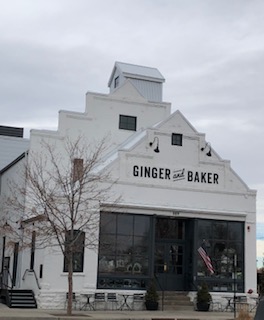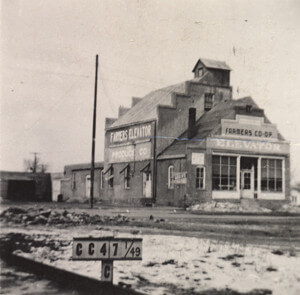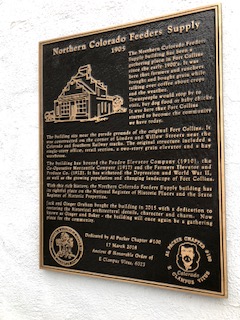
Built in the early twentieth century in Fort Collins, Colorado, the local grain elevator, along with its warehouse and retail space, provided local farmers with essential agricultural services and a served as a community hub where they could socialize. Over a century later, the building still stands at the eastern edge of Fort Collins’ historic Old Town at the corner of Willow and Linden Streets. Renovated by Jack and Ginger Graham in 2015, the historic grain elevator now houses Ginger and Baker, a boutique restaurant, and bakery that also offers cooking classes. While the names and types of business inside it changed over time, the building continues to offer a meeting spot for Fort Collins residents, and is a quiet historic narrator of the city’s agricultural roots.
Agricultural Roots
In 1905, the Poudre Elevator Company built and operated the two-story grain elevator, which provided storage and distribution of local farmers’ crops of grain. The building also contained a one-story space that could be used as an office or retail space, as well as a warehouse that stored hay.[1] At the time, Fort Collins was becoming an agricultural powerhouse on the northern Colorado plains. Farmers relied on railways to take their goods, including grain, sugar beets, and livestock, to far-flung markets. Businesses like the Poudre Elevator Company that specialized in handling agricultural goods tended to be located near railway tracks because it made shipping easier. From what is now Ginger and Baker’s patio, present-day visitors can still see the railroad tracks that attracted the Poudre Elevator Company to build on that particular spot over a century ago. [2]

Sold and renamed the Co-operative Mercantile Company in 1917, the building changed hands several times through the years, but retained its essential function as an agricultural supply company.[3] The city growing up around those businesses, however, was changing radically. By midcentury, Fort Collins’ economy had diversified beyond agriculture – a necessary response to drought in the 1950s, decreasing profits in the sugar beet industry, as well as the effects of globalization, mechanization, and other structural changes that altered the way food was produced.[4] As local agriculture declined, new industries moved into the area, creating a large industrial job market and contributing to a population boom.[5] Between 1950 and 1970 Fort Collins’ population nearly tripled.[6] The city’s geographic footprint increased along with its population and development companies acquired former farmland, and began building developments to house the city’s growing population.[7] During this time, Fort Collins also saw the rise of two skyscrapers, further signaling its growth as an urban center.[8]
Growth and Change
As Fort Collins’ population boomed and the city around the old grain elevator changed, over a thousand miles east in Washington D.C., Congress was developing the National Historic Preservation Act (NHPA) Passed in 1966, the legislation responded to the poor condition of many of the nation’s historic buildings, many of which were falling into disrepair and needed preservation.[9] The NHPA provided a structure and process that citizens, as well as state and local governments, could use to document and preserve historic buildings and places. It also created a State Historic Preservation Office in each state to provide guidance and review. The legislation had a local impact as well, and Fort Collins established its first historic preservation body, the Landmark Preservation Commission, only two years later in 1968. It added dedicated preservation staff to the city’s Planning Department in 1984 and became a Certified Local Government in 1991.[10] Since then, the City of Fort Collins has continued to actively partner with citizens and businessowners to preserve historic structures such as the historic grain elevator.

In 2015, Jack and Ginger Graham bought the building as the future home of Ginger and Baker, a restaurant, bakery, and shop. While they wanted to retain the building’s historic character, the Grahams did make some alterations. They decided to add a two-story addition, significantly increasing the size of the building.[11] During renovations, Jack and Ginger discovered the original stone foundation of the building to be structurally sound, but other aspects of the building needed work since the building had been largely abandoned for many years.[12] The grain elevator remains standing with a little extra support added during the renovation of the building. The building’s unique details – exposed brick walls, sliding doors, and patinaed wood beams – are evidence of its historic function as a structure that supported industrial-scale agriculture.[13]
Despite its new function, the new owners keep much of the building’s original look and feel as an homage to Fort Collin’s history as an agricultural hub on the northern Colorado plains. It continues this legacy by supporting local industry in its wide selection of locally brewed beers and handmade pies, reinforcing their customers’ connections to the city’s agrarian history, ad highlighting the ways that agriculture and food continue to matter in the present.
-By Lorena Garrod, PLHC Intern
Published on 06/08/2020
Other adaptive reuse projects in Fort Collins:
Coy-Hoffman Barn on the Woodward Headquarters Campus: https://www.fcgov.com/historicpreservation/pdf/coy-hoffman-farmstead.pdf
Jessup Farms: http://www.jessupfarm.com/history
Harmony Mill: https://www.fcgov.com/historicpreservation/pdf/top20list.pdf
Sources
[1] “History,” Ginger and Baker, Accessed April 29, 2020, https://gingerandbaker.com/history/.
[2] Ibid
[3] Ibid
[4] Eric Twitty, Silver Wedge: The Sugar Beet Industry in Fort Collins, SWCA Environmental Consultants, 2003, 59-60, Accessed April 29, 2020, https://www.fcgov.com/parkplanning/files/silver-wedge_the-sugar-beet-industry-in-fort-collins_a-historical-context.pdf.
[5] Ibid
[6] “Fort Collins Detailed Time Line 1960,” Fort Collins History Connection, Accessed April 23, 2020, https://history.fcgov.com/timeline/1960.
[7] Alice Stice, “As Larimer County Grows, Farmland Vanishes,” Coloradoan, August 18, 2016, Accessed April 29, 2020 https://www.coloradoan.com/story/news/local/fort-collins/2016/08/19/larimer-county-grows-farmland-vanishes/88984858/.
[8] “Fort Collins Detailed Time Line 1960,” Fort Collins History Connection, Accessed April 23, 2020, https://history.fcgov.com/timeline/1960.
[9] National Trust for Historic Preservation, “Recommendations,” in With Heritage So Rich (Random House, 1966), pp. 208-211.
[10] “Program History” About Historic Preservation Services, The City of Fort Collins, Accessed April 30, 2020, https://www.fcgov.com/historicpreservation/historic-preservation-services.
[11] Pat Ferrier, “Peek inside Ginger and Baker’s River District Reinvention,” Coloradoan, June 19, 2017, Accessed April 29, 2020, https://www.coloradoan.com/story/money/business/2017/06/09/peek-inside-ginger-and-bakers-river-district-reinvention/373569001/.
[12] Ibid
[13] Ibid